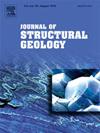低岩化地层中泥质膜的连续性
IF 2.6
2区 地球科学
Q2 GEOSCIENCES, MULTIDISCIPLINARY
引用次数: 0
摘要
断层封闭算法主要是根据露头开发的,其中富粘土断层岩主要来自页岩层。我们分析了泥页岩的连续性,并考虑了它们对新西兰互层砂岩-页岩层序断层封闭性的影响。我们的数据来自6个低岩化地层(埋深≤1.5 km)的沿海露头,这些露头被194个小正断层的随机样本置换,位移为0.02-1.4 m。每条断层在横截面上100%暴露,并取代了一个页岩层,其厚度超过了层厚。断裂的页岩层呈现出一系列的几何形状,从无泥斑到不连续泥斑和连续泥斑。这三种涂抹类型的相对频率在六个露头位置之间有所不同,每个位置高达60%的页岩床没有涂抹,不连续的涂抹通常覆盖了页岩床截止点之间断层迹线长度的50%。样品区域间页岩涂抹连续性的一阶变化反映了页岩成分和能力的差异,而局部单个涂抹的几何形状可以由断裂带内滑动面的数量和位移控制。许多层上没有页岩涂抹会降低断层封闭的潜力,这可以在页岩涂抹算法中得到解释。本文章由计算机程序翻译,如有差异,请以英文原文为准。
Continuity of shale-smears in poorly lithified strata
Fault-seal algorithms were primarily developed from outcrops where clay-rich fault-rock is mainly derived from shale beds. We analyse the continuity of shale-smears and consider their impact on fault seal for interbedded sand-shale sequences in New Zealand. Our data are from six coastal outcrops of poorly lithified strata (burial depths ∼≤1.5 km) displaced by a random sample of 194 small normal faults with displacements of 0.02–1.4 m. Each fault is 100% exposed in cross section and displaces a single shale bed by more than the bed thickness. The faulted shale beds display a range of geometries from no smear, to discontinuous smear and continuous smear. The relative frequencies of these three smear types vary between the six outcrop localities, with up to 60% of shale beds at each locality showing no smear and discontinuous smears typically covering <50% of the fault-trace length between shale-bed cutoffs. First-order changes in shale-smear continuity between sample localities reflect differences in shale composition and competence, while locally the geometries of individual smears can be controlled by the number and displacements of slip surfaces within fault-zones. The absence of shale-smear on many beds decreases fault-seal potential and could be accounted for in shale-smear algorithms.
求助全文
通过发布文献求助,成功后即可免费获取论文全文。
去求助
来源期刊

Journal of Structural Geology
地学-地球科学综合
CiteScore
6.00
自引率
19.40%
发文量
192
审稿时长
15.7 weeks
期刊介绍:
The Journal of Structural Geology publishes process-oriented investigations about structural geology using appropriate combinations of analog and digital field data, seismic reflection data, satellite-derived data, geometric analysis, kinematic analysis, laboratory experiments, computer visualizations, and analogue or numerical modelling on all scales. Contributions are encouraged to draw perspectives from rheology, rock mechanics, geophysics,metamorphism, sedimentology, petroleum geology, economic geology, geodynamics, planetary geology, tectonics and neotectonics to provide a more powerful understanding of deformation processes and systems. Given the visual nature of the discipline, supplementary materials that portray the data and analysis in 3-D or quasi 3-D manners, including the use of videos, and/or graphical abstracts can significantly strengthen the impact of contributions.
 求助内容:
求助内容: 应助结果提醒方式:
应助结果提醒方式:


